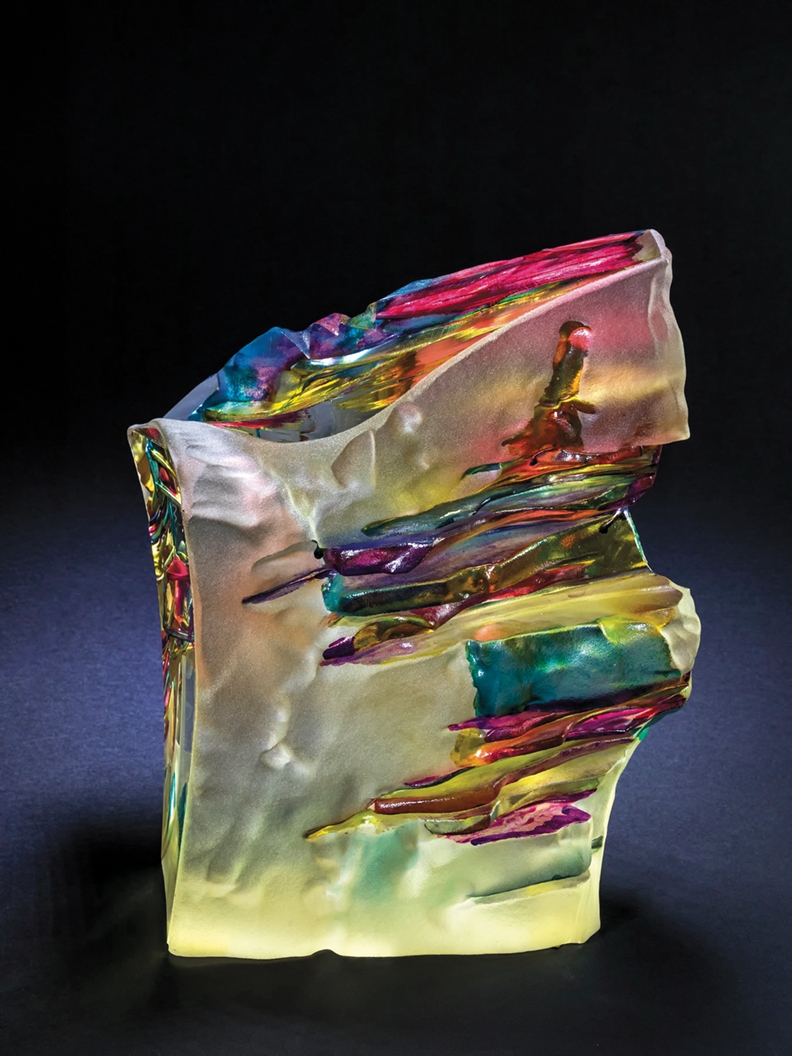Half a century later, the contemporary glass movement continues to gain momentum with competitions, exhibits and college programs. With Global Glass: A Survey of Form & Function, the Kalamazoo Institute of Arts is diving into this unique art movement.
The exhibit includes 65 functional and sculptural glass works of art from the mid-1960s to the present day, all part of the 500-piece Alfred Berkowitz Collection housed at the University of Michigan Dearborn. Among the 56 artists represented are glass giants Harvey Littleton, Howard Ben Tré, Dale Chihuly, Ann Robinson and Kate Vogel.
The Kalamazoo exhibit will be representative of pieces early in the movement.
“In the beginning, (glass) leaned more toward functional objects, because a lot of artists came out of the ceramic movement where they were taught the forms and function of ceramic-ware,” said Don Desmett, curator of the exhibit. “The KIA exhibit will be loosely divided between function and sculptural elements.”
In the glass world, function is defined as any piece that holds something else. Although there is still a lot of functionality in contemporary glass, it all leans toward sculptural connections.
Desmett said the contemporary glass movement had its beginnings in the 1960s when Harvey Littleton and Dominic Labino, a chemist, presented a workshop at the Toledo Museum of Art. Together, they showcased the possibilities for glass artists to create works of art as opposed to strictly designing glass objects for companies, such as Libby Inc. and Corning Inc. The pair developed small-capacity kilns and demonstrated the effect that different temperatures could have in the creative process.
Littleton went on to develop the United States’ first glass program, at the University of Wisconsin-Madison. As the interest level rose, studios became larger and more technically advanced, and artists are able to experiment and create in many more ways.
Students of the glass arts learn about the impact of gravity and heat as well as chemistry and physics, while also gaining a better historical perspective.
“Before this movement began, glass artists were designing things that could be mass-produced,” Desmett said.
Although some companies would have artists create limited-series pieces, the majority of those who worked for these companies designed more functional pieces that could be mass-produced, including plates, mugs and bowls.
The contemporary glass movement filled a void created by a period of minimalism, pop art and optical abstraction in the art world that was not necessarily connecting with a larger audience, Desmett said.
“The danger for glass is that it has to be beautiful,” he said. “If you look at any glass object, it’s going to catch light. The objects themselves became very beautiful and artists took advantage of that.”
Contemporary glass collectors — such as Berkowitz, whose collection comprises the show — contributed early on to the resurgence of the movement. Galleries, including some in the Detroit area, fed the appetites of these collectors with glass exhibits showing the works of American artists.
Desmett said glass artist Dale Chihuly also deserves a fair amount of credit for the resurgence.
“Chihuly sort of broke out of the boundaries of doing museum shows and worked with botanical gardens like Meijer Gardens that helped bring in a larger public who maybe hadn’t looked at this art form before,” Desmett said.
As with any artistic medium, some glass artists are able to work themselves into a position to make a living based solely on their craft. They may teach or open their own programs.
“A number of them form really good connections around the world,” Desmett said.
However, as with anything, the lower the values go for pieces, the harder it is for artists to break out and continue to make a living. Still, Desmett has a personal connection to two glass artists who were able to make a living pursuing their passions. His late brother Ron taught at Carnegie Mellon University and co-founded the Pittsburgh Glass Center with his wife, Kathleen Mulcahy. She was the first woman in the United States to teach glass art at the university level when she joined the faculty of Carnegie Mellon.
Ron Desmett’s work is displayed in important collections around the country, including the Renwick Gallery of the Smithsonian American Art Museum and the Carnegie Museum of Art.
“He was the anti-Chihuly. He did these black, super-opaque, organic works,” Desmett said of his brother. “I was fairly close to what was going on through osmosis. I met a number of artists through him whose work was socially and politically motivated.”
Global Glass: A Survey of Form & Function
Kalamazoo Institute of Arts
314 S. Park St., Kalamazoo
June 23-Oct. 14
kiarts.org





